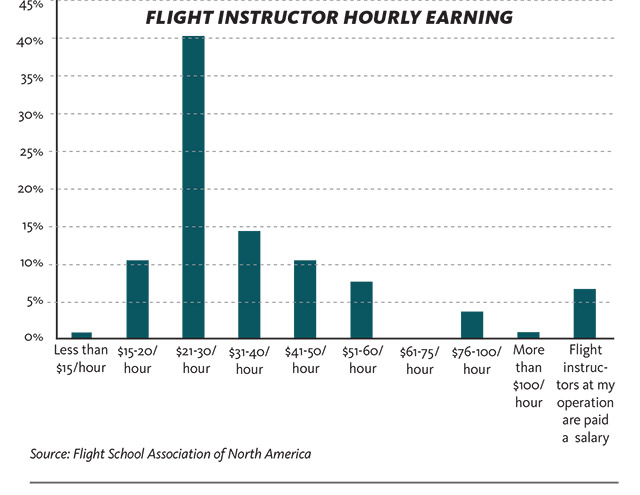
As flight schools struggle to hire and retain CFIs, flight instructor compensation packages might have to become more creative, according to the results of a compensation trends survey conducted by the Flight School Association of North America.
The survey queried participants about compensation levels, benefits, how instructors are paid, in what environments (fixed-base operators, independent instructors, collegiate/university training) the training was provided, and whether instructors are considered staff or independent contractors, said Jason Blair, a designated pilot examiner and flight instructor in Michigan who presented the survey February 10 at FSANA’s annual meeting. Surveys were sent to about 1,700 flight training providers, with 104 responses received.
Independent flight instructors represented 43.2 percent of the responses. Standalone academy-style training providers represented 23 percent. Fixed-base operators represented 18.2 percent; college or university programs made up 5.7 percent; and CFIs who provided simulator-based instruction represented 1.9 percent. The remaining 7.6 percent of respondents said they represented some other type of operation.
More than two-thirds (68 percent) of respondents said they are having problems finding enough instructors to meet customer demand, or are having difficulty finding experienced, qualified instructors. Just 31 percent said they have no problems hiring enough qualified CFIs.
The majority (40.3 percent) of respondents said flight instructors earn between $21 and $30 per hour. Another 14.4 percent said they earn between $31 and $40 per hour. There were 10.5 percent of respondents who said CFIs earn between $41 and $50 per hour, while another 10.5 percent said instructors earn between $15 and $20 per hour. For 7.6 percent of respondents, $51 to $60 is the hourly rate, and 3.8 percent said they earn between $76 and $100 per hour. One percent of respondents said they earn more than $100 per hour, and another 1 percent said they earn less than $15 per hour. Finally, 6.7 percent of respondents said instructors were paid a salary versus an hourly rate.

Healthcare benefits were not widely provided to survey participants (just 21 percent), but more than half of survey respondents reported that they receive discounted flight time, while 23.1 percent said they receive reduced-rate or free educational coursework. Twenty-one percent said they receive paid vacation time, while 18.9 percent said they receive paid holidays, and 17.8 percent reported paid sick days. Other, unspecified benefits in addition to compensation were reported by 36.8 percent of respondents.
Meanwhile, a significant percentage of respondents (34.6 percent) said they’re asked to perform ancillary duties (marketing, cleaning facilities, even landscaping) but aren’t compensated for that work. Some 27.8 percent of respondents said they don’t perform additional services, while 20.1 percent said they do the extra work and are compensated at a lower level than for instruction; 10.5 percent said they perform additional work and are compensated at the same rate as for instruction.
These practices can play a key role in retaining flight instructors—or encouraging them to find another employer. “Is your flight instructor the lowest person on your payroll?” Blair asked the group.
With the regional airlines hiring at a rapid pace, the demand for flight instructors will continue as pilots reach 1,500 hours and move up the career ladder, Blair noted. While Part 141 schools generally have a supply of their own students that they can hire, Part 61 schools might struggle to hire flight instructors, he said. What’s more, about 1,000 fewer pilots took the CFI knowledge test over the last two years. “It may be harder to find a CFI,” he said.
Here’s where creative compensation practices can give a prospective employer an edge, Blair said. Checkride bonuses and different billing structures for different types of instruction are two methods anecdotally cited by survey respondents, he said. Additionally, employers might consider some type of arrangement that helps CFIs remain current and keep their certification, he said. “Some employers are offering interesting compensation benefits, typically with service contracts,” he said. “A few are paying for [employees’] training. A few are paying for the initial CFI.”



